
HMS Loch Alvie was a Loch-class frigate of the Royal Navy, named after Loch Alvie in Scotland. She was ordered by the Royal Navy during World War II, but did not see action with them, having transferred to the Royal Canadian Navy before commissioning. After the war she returned to the Royal Navy and would pass in and out of service until 1963.

HMS Euryalus (F15) was a Leander-class frigate of the Royal Navy (RN). Like the rest of the class, Euryalus was named after a figure of mythology. Euryalus was built by Scotts Shipbuilders of Greenock. Euryalus was launched on 6 June 1963, and commissioned on 16 September 1964.

HMS Yarmouth was the first modified Type 12 frigate of the Rothesay class to enter service with the Royal Navy.
HMS Ambush (P418/S68/S18), was an Amphion-class submarine of the Royal Navy, built by Vickers Armstrong and launched 24 September 1945.
HMS Anchorite (P422/S22), was an Amphion-class submarine of the Royal Navy, built by Vickers Armstrong and launched 22 January 1946.
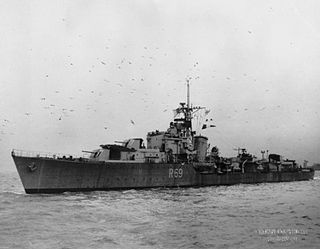
HMS Ulysses was a U-class destroyer of the British Royal Navy that saw service during World War II. She was later converted into a Type 15 fast anti-submarine frigate, with the new pennant number F17.

HMS Undaunted was a U-class destroyer of the British Royal Navy that saw service during World War II. She was later converted into a Type 15 fast anti-submarine frigate, with the new pennant number F53.

HMS Virago was a V-class destroyer of the British Royal Navy that served in World War II. She was later converted into a Type 15 fast anti-submarine frigate, with the new pennant number F76.

HMS Narwhal (S03) was a Porpoise-class submarine of the Royal Navy. She was launched on 25 October 1957.
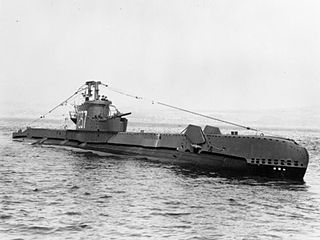
HMS Scythian was a S-class submarine of the third batch built for the Royal Navy during World War II. She survived the war and was sold for scrap in 1960.

HMS Scorcher was an S-class submarine of the Royal Navy, and part of the third group built of that class. She was built by Cammell Laird and launched on 18 December 1944. So far she has been the only ship of the Royal Navy to bear the name Scorcher. She was launched by Thomas Beacham, a Foreman Driller employed by Cammell Laird.

HMS Sea Devil was a S-class submarine of the third batch built for the Royal Navy during World War II. She survived the war and was sold for scrap in 1966.

The second HMS Telemachus was a British submarine of the third group of the T class. She was built as P321 by Vickers Armstrong, Barrow, and launched on 19 June 1943. She served in Far Eastern waters for most of her wartime career, and was responsible for the sinking of the Japanese submarine I-166. Following the war she was deployed to Australia to operate with the Royal Australian Navy until 1959. She was scrapped in 1961.
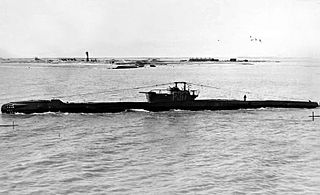
HMS Tally-Ho was a British submarine of the third group of the T class. She was built as P317 by Vickers Armstrong, Barrow and launched on 23 December 1942. She has been the only ship of the Royal Navy to bear the name, that of the hunting call, "Tally-Ho!".

HMS Tabard was a British submarine of the third group of the T class. She was built by Scotts, Greenock, and launched on 21 November 1945. So far she has been the only boat of the Royal Navy to bear the name Tabard, after the item of clothing. Having been launched after the war, she was selected, along with a number of boats of her class, to try out new streamlining techniques based on the German Type XXIII submarine. In May 1963, she was involved in a collision with HMAS Queenborough, and on 10 February 1964 she underwent exercises with HMAS Melbourne and HMAS Voyager in the hours before their collision. When she returned to the UK, she became the static training submarine at the shore establishment HMS Dolphin, until 1974 when she was sold and broken up.

HMS Turpin was one a group three T-class submarines of the Royal Navy which entered service in the last few months of World War II. So far she has been the only ship of the Royal Navy to be named Turpin. She was sold to Israel in 1965 and commissioned into the Israeli Sea Corps in 1967 as INS Leviathan.
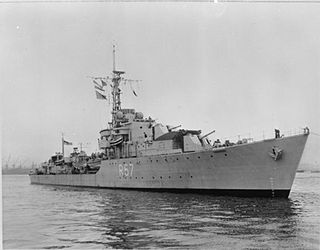
HMS Cossack was a Royal Navy C-class destroyer launched on 10 May 1944.
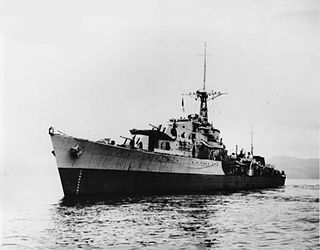
HMS Cassandra was a C-class destroyer of the Royal Navy, ordered in February 1942 from Yarrow Shipbuilders. She was originally to be named HMS Tourmaline but this was changed to Cassandra in November 1942 to fit her revised class name. She was laid down on 30 January 1943 and launched on 29 November 1943.
HMS Meon was a River-class frigate that served with the Royal Navy and Royal Canadian Navy in the Second World War. The vessel was used primarily as a convoy escort in the Battle of the Atlantic, but also took part in the Invasion of Normandy. After the war, the ship was converted to a headquarters vessel for amphibious operations, and saw service in the Persian Gulf from 1952 to 1965, before being scrapped in 1966. She was named for the River Meon in the United Kingdom and was sponsored by the town of Bletchley in Buckinghamshire.

HMS Contest was a C-class destroyer of the Royal Navy, built by J. Samuel White, Cowes. Laid down on 1 November 1943 and commissioned on 9 November 1945, she was the Royal Navy's first all-welded warship. She was scrapped in 1960.


















